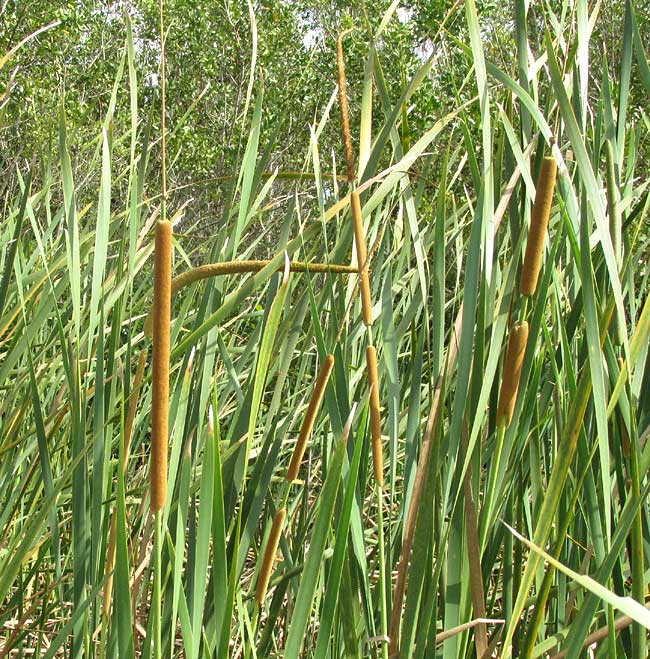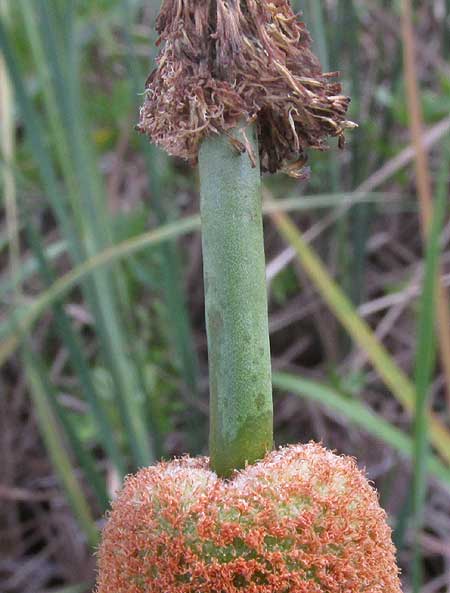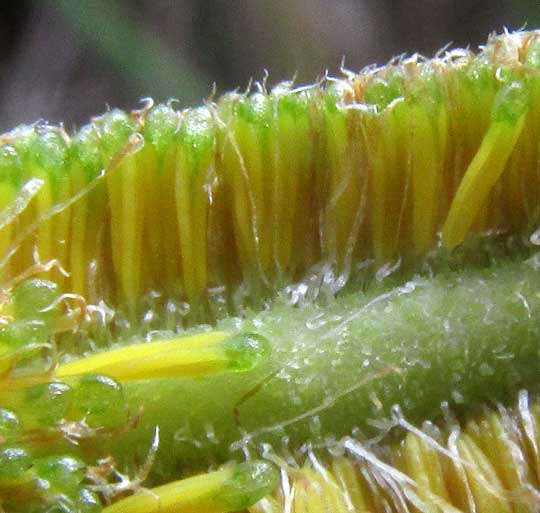Excerpts from Jim Conrad's
Naturalist Newsletter

from the February 22, 2015 Newsletter issued from Río Lagartos, on the Yucatan Peninsula's northern coast (~N21.60°, ~W88.16°), Yucatán state, MÉXICO
SOUTHERN CATTAILS
In this area along the edges of many ponds with brackish to nearly fresh water you see dense thickets of ten-ft-high (3m) cattails, as shown below:

Nowadays the cattails are producing flowering and fruiting heads, which look much more like skewered frankfurters than cat tails, as you can see at the top of this page.
In cattails, male flowers are densely arranged in spikes atop the flowering stem, or rachis. Each male spike is separated from the much thicker female spike below it by a short section of naked rachis. A picture showing the bottom of a male spike, with the anthers turning brown and shriveling after having already released their pollen, separated by the naked rachis from the top of a maturing female spike below, is seen below:

In that picture, male flowers are at the top, and maturing ovaries of female flowers are at the bottom, where the ovaries' tops create a shiny, green, hard-looking floor beneath a layer of brownish fuzz. The fuzz consists of maturing styles and stigmas, and probably protects the maturing ovaries from sunlight and temperatures extremes.
If you remove flowers from a section of male spike you can see the 2.5mm tall (1/10th in) anthers stacked next to one another, as shown below:

In the particular population I photographed, many plants bore two skewered-frankfurter-like groupings of female flowers below the male section instead of the usual one. I'd seen such instances of two female sections being produced on one axis before, though not as commonly occurring as here. I wondered if these cattails might be a different species from what I thought they were, which was the Southern Cattail, TYPHA DOMINGENSIS, which we also had in southern Texas. But, no, taxonomists consider all our Yucatan cattails to be Southern Cattails.
Southern Cattail is a very successful species, considered to be native worldwide in warmer countries. In wetlands where the soil and/or vegetation is disturbed, Southern Cattail moves in and can form pure, one-species stands. The species thrives in waters with low oxygen content and survives brackish water, plus in areas where humans alternately drain and flood land without regard to natural cycles, Southern Cattail has an advantage over other species. However, in undisturbed wetlands with low nutrient levels, it grows only sparsely.
Traditionally, in many cultures Southern Cattail leaves have been used for weaving. The online "Invasive Species Compendium" reports that in July, 2007, in central Mexico an armful of Southern Cattail leaves sold for US $1-3. The Southern Cattail's rhizomes are starchy and nutritious, but so fibrous that they're hard to eat. Drying and pounding them can make them edible. At a certain time of year, just before the male flowers release their protein-rich pollen, the male spikes can be roasted and daubed with butter, and eaten like corn on the cob.